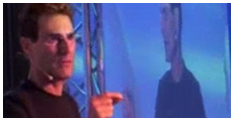Chapter 8
Distance effects
Classical physical force fields behave in a predictable manner which can be expressed mathematically by equations of vector algebra. The simplest static fields become weaker as we depart from their source, for example proportionally to the inverse square of the distance travelled. Time-varying fields are associated with wave-motion, and situations such as standing waves can arise, in which the variation of force with distance is not a uniform decrease with increasing distance from the source, but, rather, a periodic variation in a certain direction. Other more complicated distance effects are to be found in physics.
What distance effects are to be found in metal-bending phenomena? We might suppose that they differ from other physical fields in that there is some participation by the unconscious mind of the subject. They could be influenced by psychological factors.
My experience has been that the unconscious mind of the subject plays the key role in placing the quasi-force fields which bend metal. Evidently there is comparatively little bending of metal more than a few feet away from the subject. On the other hand, it is possible for the subject to ‘focus’ the field onto a particular point. Sometimes the subject feels that the force does not come ‘from’ him but ‘from’ outside him; is some outside entity responsible? Although the Nicholas Williams data were examined for dependence of signal magnitude on distance from subject, they showed a very wide spread. In the radial horizontal configuration, which is the most suitable for analysis, the range of variation of strength with distance seems to be more or less random.
I determined to conduct further experiments with Stephen North designed to throw light on the dependence of spontaneous dynamic strain signal magnitudes on distance from the subject. I found that with Stephen it is much slower to experiment with each strain gauge mounted on its individual metal strip than with an array of strain gauges mounted on a single strip. Synchronous data are much less frequent with individual strips. If the metal strip is chosen to be sufficiently thin, as has been shown by experiments in chapter 6, the dynamic strains can be regarded as mainly bending rather than stretching. Although they are dynamic they do not propagate extensively as shock waves along the strip. This can readily be demonstrated for normal pulses, produced artificially at the position of one of an array of strain gauges; the other strain gauges do not show significant pulses. Such an array can also be used for finding how the paranormal pulses are distributed along the metal strip. Are they all centred on the point at which the strip subsequently bends (if it does)? Or are they uniformly distributed along its length? Are the stronger ones at the end closest to the subject, or at the other end? Are they random?
In one of my first sessions with Stephen North a long metal strip carrying three strain gauges was mounted in the radial horizontal configuration, and data were recorded. After an unsettled period, the signals settled down into synchronous extension pulses, there being more than fifty such events, many of them multiple. It appeared in the first experiment that the strengths of the signals diminished with increasing distance from Stephen.
During the signals Stephen was sitting with his left hand about four inches from the end of the metal strip; he was relaxed, but refraining from movement as far as possible. I ensured that the three strain gauges were all approximately equally sensitive; this was checked by placing the entire metal strip under tension and recording the three signals. Corrections were applied if this was not the case, but in practice they were seldom more than ± 5 per cent. (Similar corrections were applied in the back-to-back strain gauge experiments described in chapter 6.)
In subsequent sessions with Stephen I repeated this distance effect experiment. But the results were rather different from those obtained in the first experiment. In general the centre strain gauge responded most strongly, while the strain gauge nearest to Stephen received rather weaker signals. I performed further experiments with three strain gauges, and later with five and six mounted on a single specimen; for each event the relative magnitudes of the signals at each strain gauge were different. It became clear to me that any ‘distance effect’ which might exist could best be described in terms of a ‘region of action’ and a ‘centre of action’. At this centre the signals are strongest, and they diminish on each side of it. Thus in the first session the centre was between the subject and the nearest strain gauge, and in later sessions it was closer to the centre strain gauge. Such a concept would be consistent with qualitative observations on metal-bending; spoons do not usually bend uniformly along their length; they bend at one particular place where the centre of action is concentrated. I have on occasion observed metal strips bend into exact parabolic arcs, once as long as 40 cm, indicating a bending moment uniform along the entire length; but this type of behaviour is comparatively rare (see chapter 9).
How does the peak signal strength I vary with distances from the centre of action? A detailed analysis requires more than three strain gauges, but at first I was satisfied with fitting the data to a standard probability relationship. l used a simple Gaussian equation:
I = l0*exp {-alpha*(x – x0 )^2 }
This equation represents a bell-shaped curve of width inversely related to the parameter alpha. and centred on a point x = x0, which is the actual ‘centre of action’. The variable x represents the distance from the end of the metal strip which is closest to the subject.
Each triplet of signals (or later quintet or sextet of signals) is computer fitted to this equation with different values of I0, x0 and alpha. If the variation of signal strength over the entire metal strip were to follow this behaviour (which is the simplest assumption), the implication is that the strain signals occur in a region of variable size, centred on a point of variable position; and they are of variable strength. These variations lie within certain limits described by normal statistics; probable errors e have been calculated; and a histogram of x0 values during a session is shown in Figure 8.1.
I repeated the three strain gauge experiment some eight times, with Stephen North and also with Mark Henry and Julie Knowles. The metal strips were of different lengths, and were arranged in three different orientations: radially from the subject, in a horizontal plane, RH, with the end equidistant from the subject in a horizontal plane, EH; and vertically, V. In each orientation the behaviour was similar; there is repeatability.
The results of fittings of different sessions with Stephen North are analysed in Table 8.1. The simple conception of a centre of action, with Gaussian variation of signal strengths, is vindicated. The extent of the region of action is, as we have seen, determined by the inverse of the parameter alpha. And we do not yet know how alpha depends upon length of specimen, since this has not as yet been varied much.
Of course I do not suggest that an exact Gaussian profile is maintained over the length of the metal strip. A single Gaussian equation with positive alpha can always be fitted to any three signals (provided they are convex; concave configuration yields negative alpha) and there is no question of over-determination. The data from five and six in-line strain gauges show the extent of the scatter; they fit much less precisely on a single Gaussian curve, as can be seen from the two examples represented in Figure 8.2. These are chosen from among the best and worst fits to signal quintets in session SN DD; the quality of the fit is related to an error parameter e = {((I – I0)^2)/n}^(1/2)/I0, and this is tabulated together with the Gaussian parameters in Table 8.2. A good idea of the grouping of signal magnitudes within a single session (Stephen North DD) can be obtained from this Table.
The concept of a region of action has been investigated in detail only within a single metal specimen, since, as we have seen, Stephen North and other metal-benders obtain fewer synchronized signals on several individual metal specimens. This reduction in numbers was shown very clearly in an experiment with Stephen in which I mounted three strain gauges on a single piece of metal containing two thin sections. I recorded signals, and then cut through the thin sections without seriously changing the relative positions of the remaining metal strips; there were now three pieces of metal, each with its own strain gauge; the frequency of occurrence of signals was reduced by a factor of two, and the frequency of occurrence of synchronous signals by a factor of twenty; nevertheless the strength of the signals was not seriously reduced, and one of the metal strips became permanently deformed; it appears that Stephen’s surface of action is greatly stabiised by the surface of the metal; at the termination of the metal strip, the surface becomes less accurately aligned.
Figure 8.1 Histogram of distribution of values of the action xO along aluminium strip in Stephen North’s session G.
| Session | I | No. of signal triplets accepted | No. of signal triplets rejected | mean I0 | eI0/I0 | mean x0 | ex0/mean x0 | mean alpha | e-alpha/mean alpha | Length (cm) | Width (mm) | Thickness (mm) | Configuration | No. of visible deformations |
| C | 0.10 | 131 | 16 | 17.06 | 0.442 | 24.8 | 0.306 | 0.0041 | 0.244 | 40 | 7.5 | 0.75 | EH | 6 |
| L | 0.29 | 59 | 15 | 9.07 | 0.655 | 8.31 | 0.194 | 0.054 | 0.443 | 15 | 7.5 | 0.75 | RH | 6 |
| B | 0.75 | 91 | 22 | 15.71 | 0.352 | 6.03 | 1.71 | 0.0018 | 0.453 | 40 | 7.5 | 0.75 | RH | 3 |
| G | 0.11 | 76 | 3 | 13.68 | 0.397 | 10.15 | 0.348 | 0.0055 | 0.220 | 40 | 7.5 | 0.75 | RH | 1 |
| K | 0.12 | 18 | 48 | 3.28 | 0.692 | 14.95 | 0.097 | 0.0203 | 0.211 | 30 | 7.5 | 0.75 | V | 1 |
In distance effect experiments the same feature is present as was noticed in all the earlier data: the constant changing sign of the signals. All strain gauges were mounted on the same face of the metal strip, but we observed a medley of extension signals interspersed with contraction signals. The moments of change from extension to contraction appeared to be irregular, and we have not been able to associate them with any particular psychological moment during the session. Suppose that the changing represents indecision: first the ‘attempt’ is made to bend the metal one way, then, when no permanent deformation is seen, an ‘attempt’ is made to bend it the other way. We characterize the session by its ‘indecision factor’, I, defined in chapter 6 as the number of changes expressed as a fraction of the total number of signals or ‘events’. Values of I for the distance effect experiments appear in Table 8.1. Apart from the high value of 0.75 in session SN B. a value around 10-20 per cent is common.
Figure 8.2 Gaussian curve-fitting to two signal quintets from five strain gauges mounted along a single aluminium strip, whose position and length correspond with the x axis. The quality of fit is seen to be related to the error parameter e. Session DD, Stephen North.
| Signal no. | I0 (x O.2mV) | alpha | xO (cm) | e |
| 1 | 35.9 | 0.029 | 11.4 | 0.15 |
| 2 | 10.7 | 0.012 | 11.9 | 0.14 |
| 3 | 31.5 | 0.035 | 10.1 | 0.074 |
| 4 | 72.9 | 0.066 | 7.9 | 0.056 |
| 5 | 23.5 | 0.102 | 11.9 | 0.050 |
| 6 | 46.0 | 0.045 | 7.7 | 0.16 |
| 7 | 8.4 | 0.026 | 9.3 | 0.11 |
| 8 | 4.4 | 0.025 | 8.0 | 0.16 |
| 9 | 44.0 | 0.055 | 10.5 | 0.16 |
| 10 | 43.3 | 0.044 | 7.2 | 0.088 |
| 11 | 7.0 | 0.017 | 6.5 | 0.13 |
| 12 | 6.5 | 0.024 | 10.6 | 0.075 |
| 13 | 37.7 | 0.027 | 8.1 | 0.082 |
Since the metal-bender is not required to hold his hands absolutely still during a session, it is difficult to assess with accuracy the distance of the centre of action from the body. But I can make the following generalization. It is the perception of the target by the metal-bender which is the important factor; once one has perceived it and succeeded in producing signals, the centre of action apparently moves independently of the motion of the hands or body. It assists most metal-benders to hold their hands near the target in order to obtain the first signals; some but not all prefer to keep their hand close to the metal during the entire session. The attitude of the metal-bender depends on many factors, such as previous practice, psychological mood, the witnessing, the environment and the condition of the target. Distances sufficiently great to inhibit the perception appear to hinder the production of signals. The walls of the room are usually an important factor; strain gauges outside the room in which the subject is positioned very seldom receive signals. Experiments in the open air might reveal surprisingly different ‘perceptual distance effects’.
An incident which illustrates ‘perceptual distance effects’ very well occurred with Julie Knowles in early 1978. David Robertson and I succeeded in obtaining some video-tape records of her action on a strain gauge mounted within a table fork; her hands were nearly three feet away from it, but the signals persisted steadily for more than half an hour, and the fork and the moving chart-recorder pen appeared together in the picture.
Then we decided to add another metal specimen, with three strain gauges and another chart-recorder. Julie held her hand very close to the metal strip (mounted equidistant horizontal) and tried to induce signals on it. But the action persisted on the fork, still three feet away from Julie, and only very little appeared on the new specimen, despite the proximity of Julie’s hand. We have thirty minutes of chart-record from which it is clear that the physical distance is unimportant when compared with what I have called a ‘perceptual distance effect’.


Latest Articles

Motivational Inspirational Speaker
Motivational, inspirational, empowering compelling 'infotainment' which leaves the audience amazed, mesmerized, motivated, enthusiastic, revitalised and with a much improved positive mental attitude, state of mind & self-belief.



















